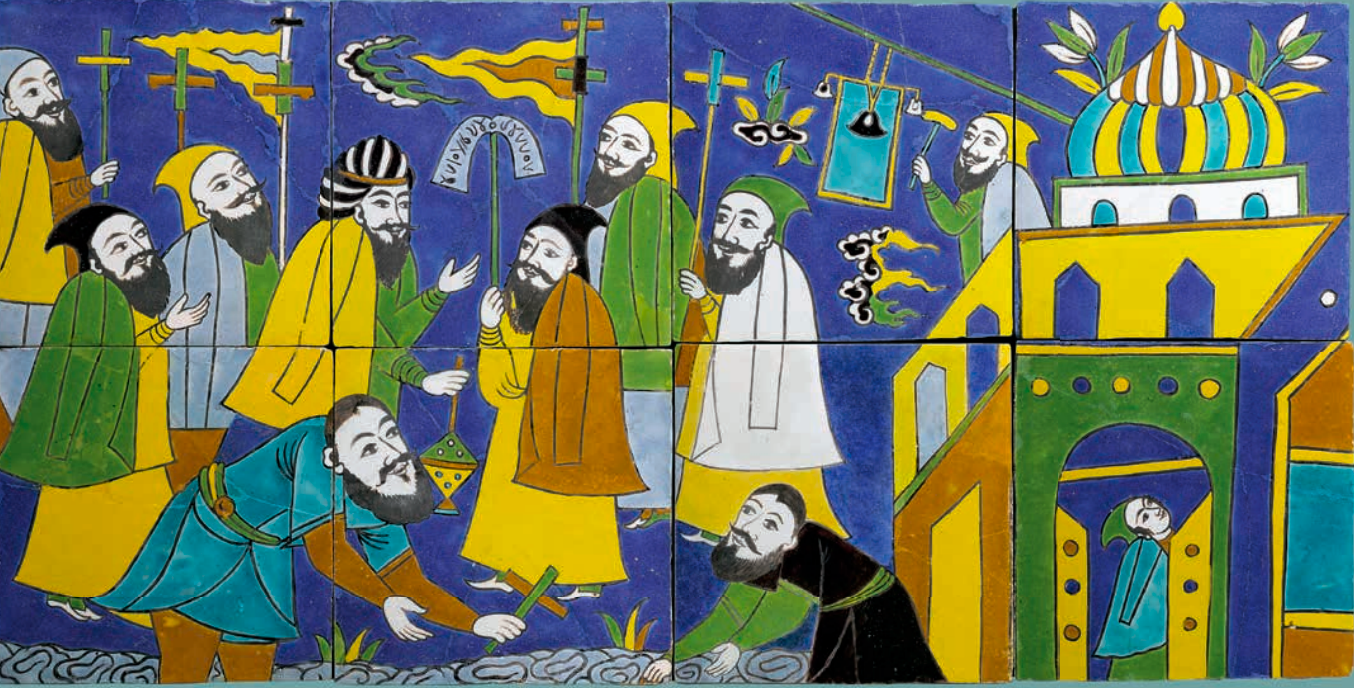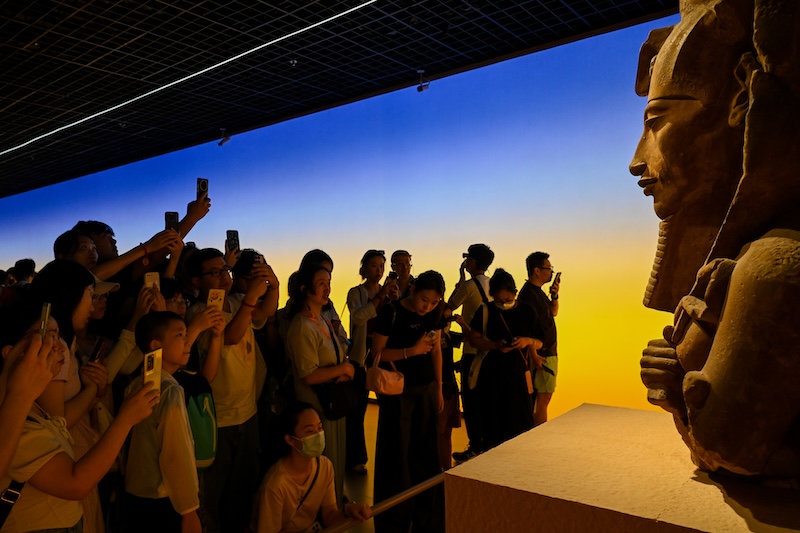
As of August 18, it has been exactly one month since the exhibition "At the Peak of the Pyramid: The Great Exhibition of Ancient Egyptian Civilization" opened at the Shanghai Museum (People's Square Branch) on July 19.
According to The Paper from yesterday's symposium on the exhibition at the Shanghai Museum, more than 310,000 visitors have stepped into the exhibition hall over the past month, captivated by this extraordinary showcase. Notably, nearly 70% of the audience was from outside Shanghai. Furthermore, the sales of cultural and creative products during this month have approached 45 million yuan, accounting for 90% of the total annual sales of cultural products in previous years. "A blockbuster exhibition has truly stimulated consumption in cultural tourism and commerce. We changed our summer plans to visit Shanghai specifically because we managed to snag tickets for this exhibition," remarked a visitor from Zhejiang.
The impressive results have also resonated with Egyptian studies scholars gathered at the museum yesterday, who joked that while studying Egyptology often receives labels like "niche discipline" and "sitting on the sidelines," they never expected it would one day be at the "center of attention."
"On the surface, it seems that the exhibition at the museum is hugely popular, but it also highlights the charm of Shanghai as a city, the rich cultural and artistic consumption atmosphere developed over the years, and the supportive policy environment that allows for bold innovative initiatives," said a representative from the Shanghai Museum.

On July 19, 2024, visitors at the Shanghai Museum view the statue of Akhenaten. Photo by Zhu Weihui, The Paper
In the first month, over 310,000 visitors explored the Egyptian exhibition at the Shanghai Museum
The "At the Peak of the Pyramid: The Great Exhibition of Ancient Egyptian Civilization" is the fourth exhibition in the Shanghai Museum's series entitled "Dialogue with the World," and it is the largest-ever exhibition of ancient Egyptian artifacts on a global scale and the highest-ranked in Asia. The exhibition unfolds an independent narrative through three sections: "Land of the Pharaohs," "Secrets of Saqqara," and "The Time of Tutankhamun," interpreting the deep meanings of ancient Egyptian civilization from different perspectives.
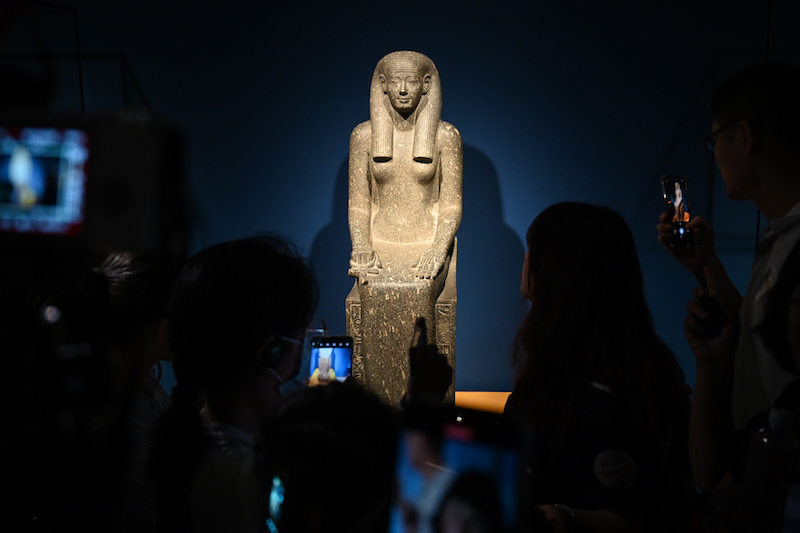
On July 16, 2024, at the Shanghai Museum, the statue of the goddess Iunet in the "Land of the Pharaohs" exhibition hall. (Photo by Zhu Weihui, The Paper)
Since opening on July 19, and as of August 18, exactly one month later, the Shanghai Museum's statistics show that a total of 317,444 visitors attended the exhibition, setting a record for the total number of visitors for a special exhibition at the museum in a month. Among this number, 221,358 were from outside the Shanghai region, accounting for 69.7%; sales of related cultural and creative products reached nearly 45 million yuan, which is about 90% of previous years' total annual sales of cultural products.

On July 16, 2024, at the Shanghai Museum, a painted anthropoid coffin of Pediamen. (Photo by Zhu Weihui, The Paper)
The "fire" of the Egyptian exhibition is naturally attributed to the meticulous planning of its content and the presentation of heavy-weight exhibits. The Shanghai Museum stated that this exhibition is distinct from previous exhibitions on ancient Egyptian civilization in China, which often borrowed artifacts from museums in Europe and the United States and narrated from a Western perspective. This time, Chinese Egyptologists participated in selecting artifacts from a local perspective and directly loaned items from Egypt. "Borrowing artifacts from Egypt is extremely difficult; the expenses are high, and the requirements are stringent. The successful organization of this exhibition owes much to the countless adjustments and hard-won communications by our curatorial team," said Zhu Xiaobo, director of the Shanghai Museum.
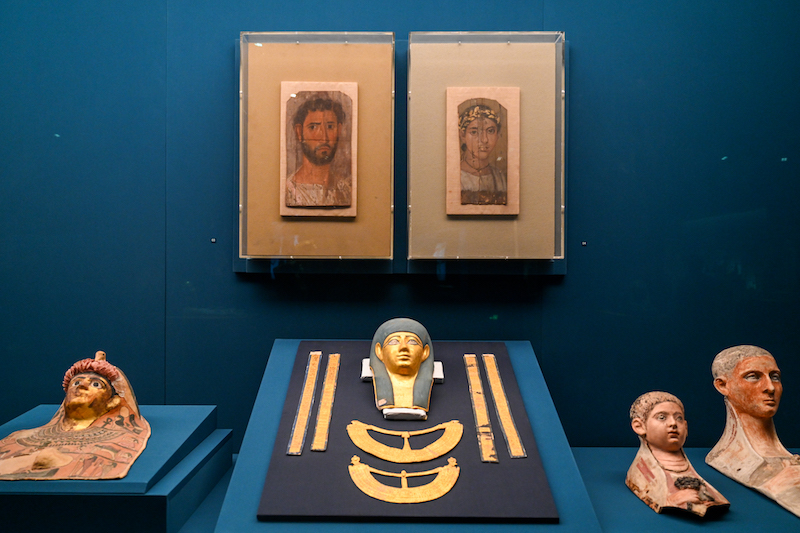
On July 16, 2024, at the Shanghai Museum, a portrait of a mummy in the "Land of the Pharaohs" exhibition hall. (Photo by Zhu Weihui, The Paper)
Chu Xin, deputy director of the exhibition department at the Shanghai Museum, previously told The Paper that the Egyptian exhibition is recognized as one of the most challenging projects to host in the industry. "On one hand, the costs are high, which discourages most museums from attempting it; on the other hand, the operations of Egyptian exhibition projects are usually monopolized by a few teams in the United States or Germany, where prices and required facilities are even steeper, leaving little room for negotiation. Furthermore, in recent years, European and American museums have rarely borrowed their Egyptian artifact collections for exhibitions, fearing international backlash or demands from the Egyptian government."
In comparison to past Egyptian exhibitions that focused only on slice narratives of specific historical periods, this ancient Egyptian exhibition at the Shanghai Museum consists of a "condensed history of ancient Egypt" along with two major thematic sections. The three segments are both independent and interconnected, with more artifacts displayed than ever before, over 95% of which have arrived in Asia for the first time, including the latest archaeological finds transported directly from the Saqqara storage facility to the museum, marking a groundbreaking precedent.
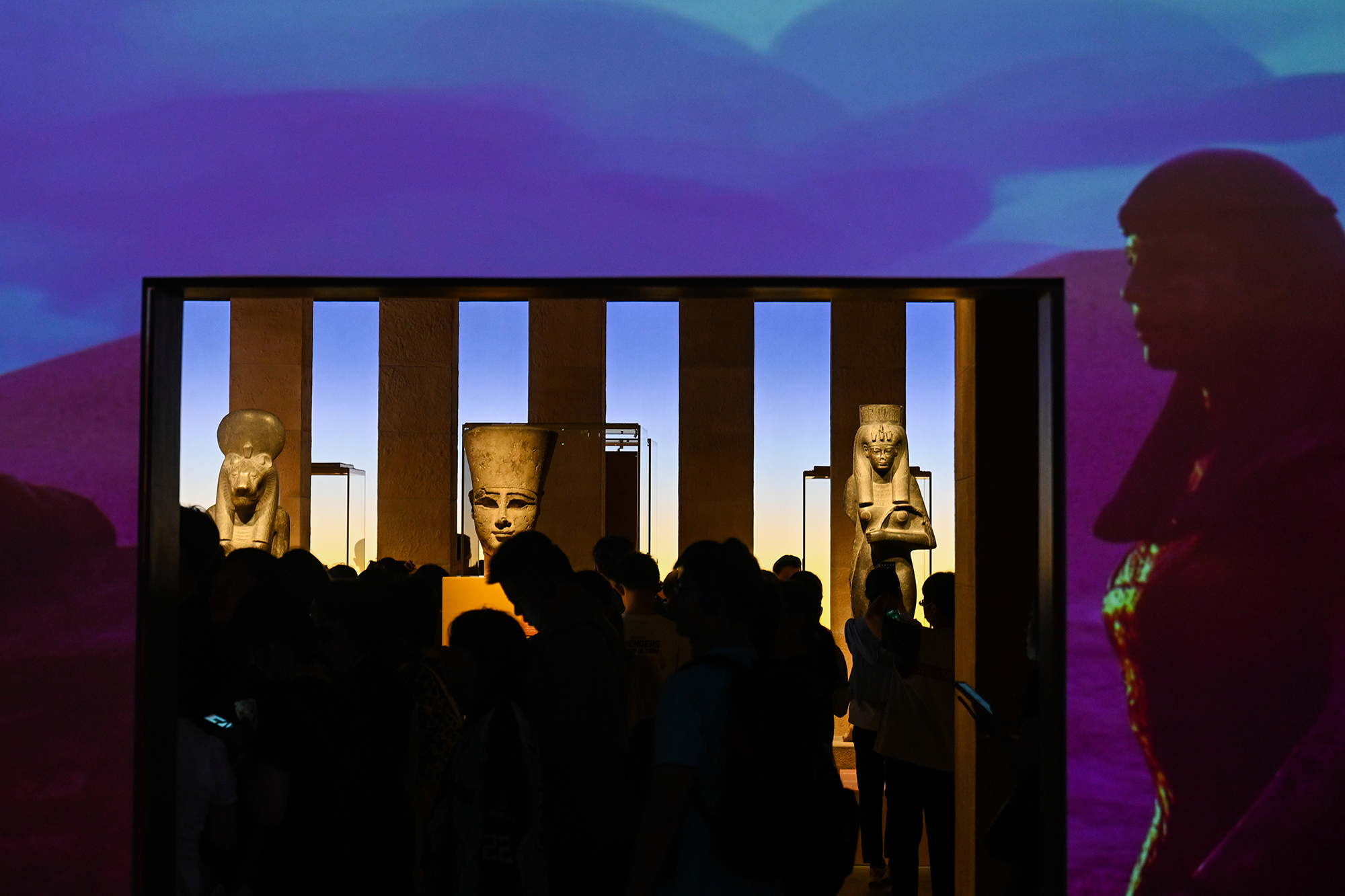
On July 19, 2024, at the Shanghai Museum, visitors photograph the statue of Tutankhamun. Photo by Zhu Weihui, The Paper
"As the chief curator of this exhibition, during the preparation process, I considered quitting many times due to the numerous challenges we faced. Thankfully, the leadership at the Shanghai Museum remained very determined, and we have a strong, hardworking, and dedicated team," said Yan Haiying, a history professor at Peking University and the chief curator of the exhibition. She also shared her journey, stating that the curatorial concept of the ancient Egyptian exhibition felt more like an "assigned topic" to her at first. She initially aimed to create a thematic exhibition, but the leadership team insisted on a comprehensive history exhibition of ancient Egypt. Gradually, she accepted this idea. After the exhibition opened, she found that the segment she enjoyed the most was indeed the "Land of the Pharaohs" which presents a rich and ever-fresh narrative of ancient Egyptian history, and she believes the decision to undertake a comprehensive history exhibition was very wise.
Due to the vast time span, large scale, and rich content of the exhibition, some visitors spent as long as six hours in the "Land of the Pharaohs" hall. "No wonder the exhibition hall of the Egyptian exhibition always bustles with people; visitors might take their time leaving," laughed Zhu Xiaobo.
How does a "blockbuster" exhibition drive cultural tourism and commercial consumption?
"The great Egyptian exhibition at the Shanghai Museum has made significant contributions to the cultural tourism consumption in Shanghai," remarked a visitor from Yiwu, Zhejiang. He shared that his family of four had originally planned to visit Jingdezhen in Jiangxi but changed their summer itinerary to Shanghai specifically to see the difficult-to-obtain tickets for the Egyptian exhibition. He estimated that each person in his family spent approximately 1,000 yuan per day in Shanghai. Clearly, this consumption has been directly driven by the blockbuster exhibition.

On July 19, 2024, at the Shanghai Museum, visitors line up to enter the museum. Photo by Zhu Weihui, The Paper
"We have found that the ongoing popularity of the exhibition has also stimulated a surge in transportation, hotel, dining, and shopping-related consumption in the surrounding areas," said a representative from the Shanghai Museum.
According to the latest demographic statistics from the exhibition, the breakdown of visitors showed a gender ratio of 4:6. In terms of age distribution, 29.11% are aged 0-22, 43.17% are aged 22-40, 17.78% are aged 40-50, and 9.94% are over 50 years old, indicating that the Egyptian exhibition appeals to a broad audience. Among the visitors, 69.7% were from outside Shanghai, with over 70% of out-of-town visitors coming specifically for this special exhibition, and others using the opportunity to visit Shanghai. As for visitor origins, the rankings were led by those from Shanghai, followed by Jiangsu, Zhejiang, Beijing, and Anhui. In terms of cultural consumption, almost half of the visitors expressed willingness or have already spent in the surrounding areas, with an average spend (or intended spend) of 1,684.19 yuan. Moreover, visitors from outside the city stayed an average of 3.59 days with total average expenses reaching 4,255.55 yuan.
Regarding the exhibition's impact on surrounding consumption, representatives from the Shanghai Museum emphasized that, in addition to the carefully curated exhibition content that attracted visitors, they took full advantage of this exhibition opportunity from the project's initiation to launch various "one-stop" cultural tourism experiences and implemented numerous innovative measures, integrating "cultural heritage + X" into the broader context of social and economic development.

The "Shanghai Museum Ship"
For example, the museum collaborated with cruise companies to create the "From the Nile to the Huangpu River - 'Shanghai Museum Ship' Ancient Egyptian Themed Cruise," hoping that visitors could view the exhibition during the day and enjoy a nighttime cruise in Shanghai, effectively linking land and waterfront experiences; partnered with a bus company to launch the "Shanghai Museum Exhibition Bus"; and joined forces with China Eastern Airlines to launch a "Flight + Ticket" package product. Additionally, they introduced an immersive project called "The Disappearing Pharaoh: An Immersive Exploration of the Great Pyramid of Khufu" in the Metaverse, hoping visitors could blend virtual experiences with real-world interactions, enhancing sensory experiences after enjoying the artifact exhibition.
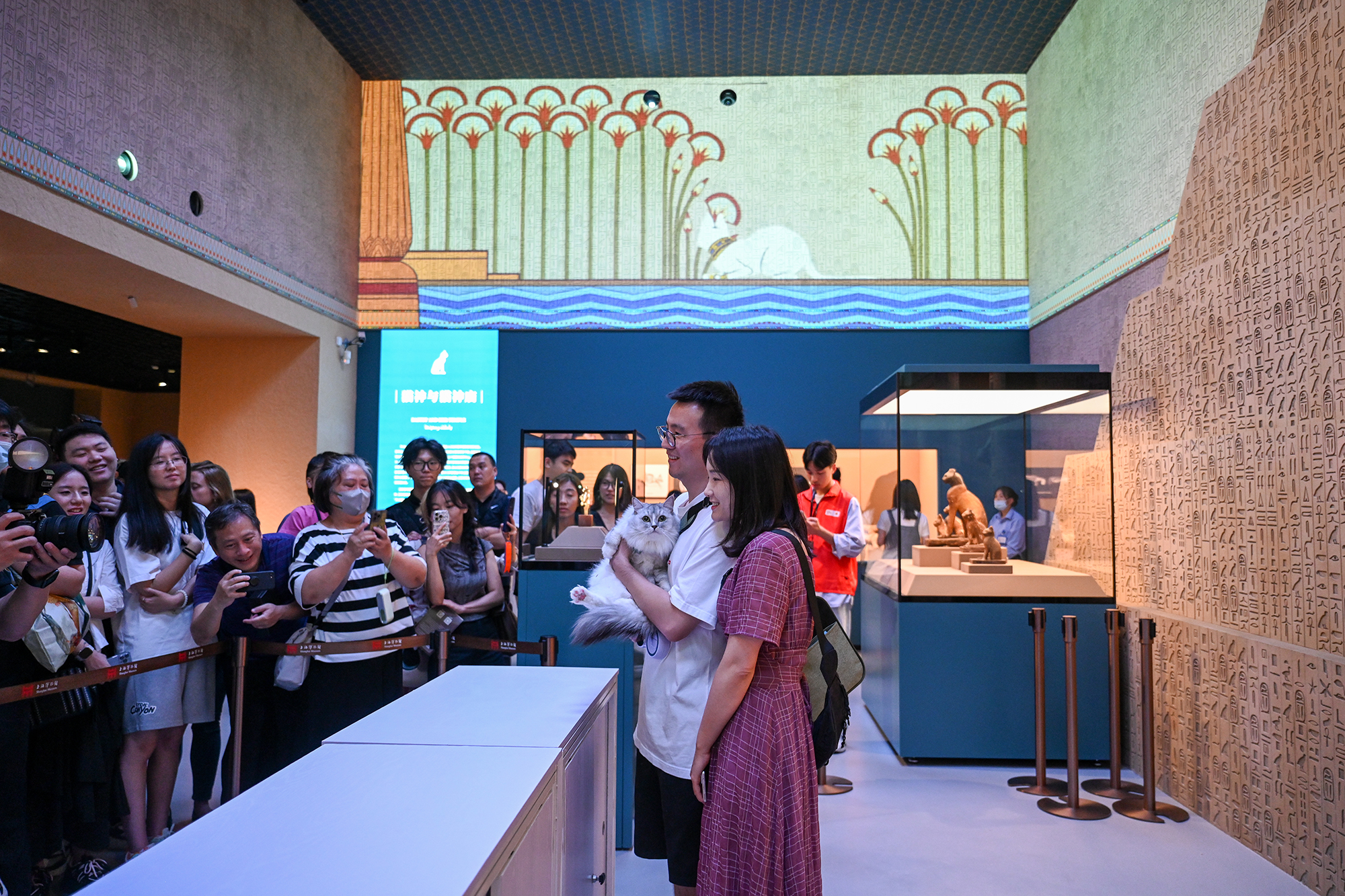
On July 27, 2024, at the People's Square Branch of the Shanghai Museum, visitors pose for photos in the cat temple area of the "Secrets of Saqqara" exhibition hall. Photo by Zhu Weihui, The Paper
Another unique aspect of this exhibition is the globally innovative "Museum Night with Cats" event, which allows visitors to bring their pet cats for an evening tour of the museum in conjunction with the Egyptian exhibition. Since the announcement, the "Cat Night" event has garnered tremendous attention and has successfully held four sessions with overwhelming positive feedback, and tickets became a rare commodity.
A representative from the Shanghai Museum explained, "Because many artifacts in this Egyptian exhibit relate to cat deities, we took the opportunity to create this experiential activity. We devoted extensive resources and efforts to prepare for the Cat Night event. The first session sold out 200 tickets in a second; all ten sessions sold out within an hour, and the search volume for pet-friendly hotels in the vicinity increased by over 50% year-on-year. This could be considered both unexpected yet anticipated."
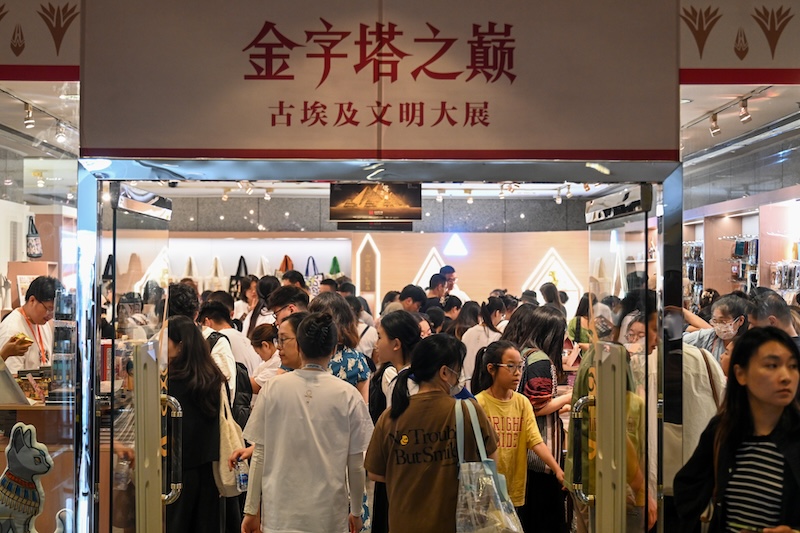
On July 19, 2024, in the cultural and creative product store of the Shanghai Museum, visitors shop for surrounding products. Photo by Zhu Weihui, The Paper
Due to the overwhelming popularity of cultural and creative products related to the Egyptian exhibition, visiting the creative store first became a unique scene associated with this exhibition.
As these "blockbuster" creative products often sell out, the Shanghai Museum has implemented purchase limits for these products, restricting each type to five items per purchase. The popularity of these items has translated into their online sales too; Tmall data indicated that the creative products from the Egyptian exhibition were sold out four times within a month; online store transactions increased by 465% year-on-year.
From “Niche Discipline” to “Egyptomania”
"On the surface, the exhibition at the Shanghai Museum is thriving. However, it is essential to recognize that it derives from the allure of Shanghai
